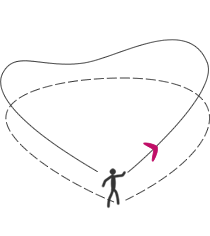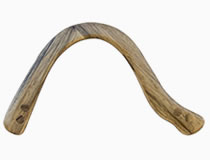Contrary to popular belief that the boomerang always returns, it must be said that this is far from the case. Only a properly made and, most importantly, properly launched boomerang can come back to you. Therefore, if you want the boomerang to return to you, choose only a high-quality product, and observing the launch technique, you can proceed with practical launches.
If you need a boomerang and you have never dealt with it, we recommend reading our article My first boomerang.
However, not all boomerangs are built to return to your hands. Depending on the required characteristics or competition conditions, the flight may vary greatly. For example, in competitions for the maximum time in the air, or simply put, for those who fly longer, the boomerang starts up and slowly descends in different zigzags. At the same time, the wind can carry it to distances of up to 50 meters or more from the launch point.
More information about the varieties of boomerangs can be found in the article Categories of boomerangs.
Next, let's look at how the most common types of boomerangs fly.
Classic boomerangs
Classic boomerangs ("ordinary", returning) have a circular or teardrop-shaped trajectory. The circular flight path is the most common, and it is associated with the way the boomerang flies. Depending on the mass and size, the flight range can vary from 3 meters to 50-60 meters. As a rule, heavier boomerangs fly further, but they are more difficult to control.
A well-tuned boomerang, when properly launched, describes a circle and returns to the launch site. However, a perfectly smooth trajectory is not at all necessary for a successful return. The same boomerang, depending on the launch, can take off on its way, descend close to the ground, fly with a constant climb and descend only at the very end of the flight.
Here are some examples of trajectories.





The same boomerang in flight can describe different trajectories. It all depends on how high the boomerang was thrown, what kind of slope it has and the strength of the throw.
Hunting Boomerangs
Hunting boomerangs fly along an almost rectilinear trajectory, do not return. The launch is carried out flat, in a horizontal plane, in the direction of the target. The boomerang hovers close to the ground, moving almost in a straight line. The flight range is 40 - 90 meters.

Long distance boomerangs
Long-range boomerangs have a trajectory similar to a highly elongated ellipse, with a high takeoff at the far point. When moving in the opposite direction, the boomerang decreases and can describe an S-shaped arc. The flight range is from 60 to 140 meters or more.

In all the examples given, in order for the boomerang to fly along its correct trajectory, it is necessary to observe the rules and conditions of launch. For example, a long-range boomerang (LD) is not capable of flying along a classical circular trajectory, and if you launch it like a regular boomerang, it will fall to the ground at the beginning of the journey.
The flight path can be strongly influenced by the wind. It is necessary to take this factor into account and launch from other angles, thereby making an adjustment to take into account the influence of wind. As a rule, the wind contributes to the rise of the boomerang, reduces the range, and can make the flight path not uniform. With a wind speed of more than 3 meters per second, it is not recommended to carry out launches, because it becomes very difficult to control the boomerang, and often impossible at all.
About setting up a boomerang
It happens that the boomerang cannot be returned, for one reason or another. For example, weather conditions may simply not be suitable for a particular boomerang. Therefore, you should have not one but several boomerangs in your arsenal that will work well under different conditions.

Also, the obligatory attributes of a lover of practical launches are stationery elastic bands, all kinds of Velcro and sticky tapes, weights and other items that can be attached to the boomerang to adjust its flight. This is an absolutely normal practice, which is used at all boomerang tournaments and club competitions.



